Enrollment management is undergoing a major shift driven by data analytics, personalised communication, and global trends. Institutions are now focusing on student success, diversity, and strategic planning to attract, enroll, and retain the right mix of students effectively.
Table Of Contents
Introduction
The landscape of student enrollment is undergoing a profound transformation, driven by demographic shifts, evolving student expectations, and rapid technological innovation. U.S. undergraduate enrollment shrank nearly 15% between 2010 and 2021, resulting in 2.7 million fewer students nationwide. This decline correlates directly with falling birth rates after the 2007–2009 recession, which means fewer college-aged individuals entering the system.
According to WICHE, high school graduates peaked at around 3.8 million in 2025, then began a sustained decline — the so-called “enrollment cliff”. After the pandemic dip, the Spring 2025 postsecondary enrollment rose by 3.2% (+562,000 students) compared to 2024. Yet, total numbers still trail pre-pandemic levels, with undergraduates at 15.3 million—down 2.4% (–378,000 students) from Spring 2020.
According to the 2025 Modern Learner Report, 58% of students begin considering schools—not programs—indicating brand and reputation hold more sway than specific course details. Moreover, 20% of undergrad “modern learners” complete their decision-making process within just one week — signalling a demand for immediacy and personalisation.
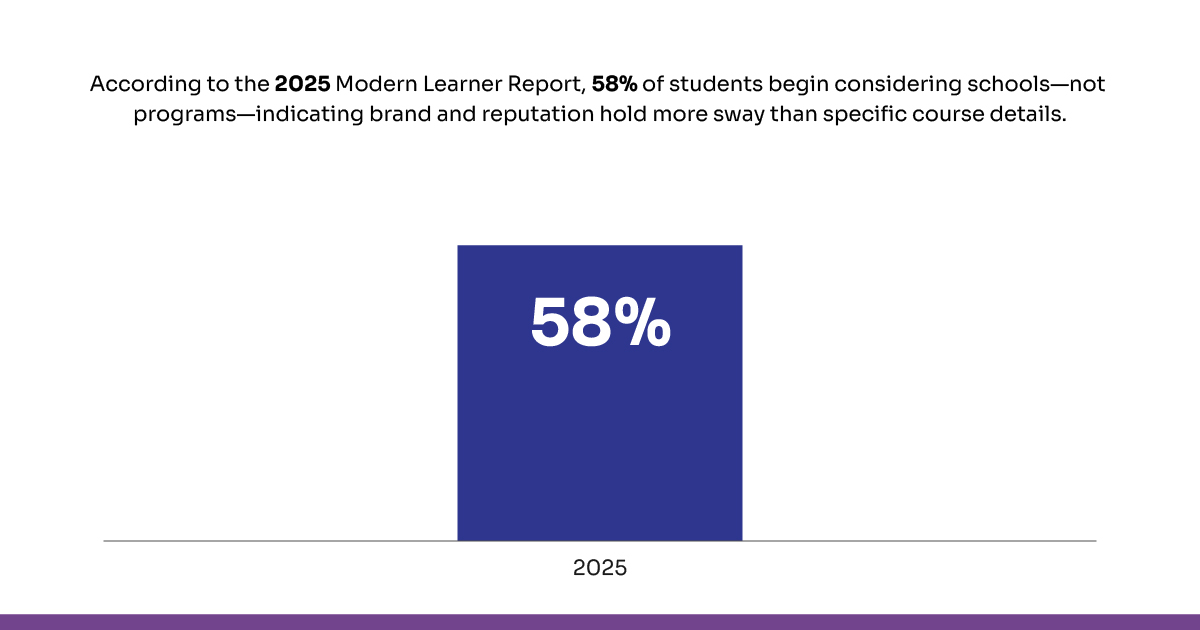
A notable case: 89% of U.S. universities use predictive modelling aimed at boosting student outcomes like retention and graduation rates.
Enrollment Management – Then vs. Now
A decade ago, enrollment management in higher education looked vastly different from the data-driven, student-centric models we see today. From rigid admission calendars to heavy dependence on standardised testing, the process was often institutional-first, not student-first.
| Feature | Then (2010–2015) | Now (2024–2025) |
| Standardised Testing | SAT/ACT required by 80%+ of U.S. colleges | 85%+ of colleges are now test-optional for Fall 2024 |
| Marketing Approach | Bulk print mail, generic emails | Behavioural targeting, AI-driven personalisation, multichannel engagement |
| Admissions Calendar | Fixed seasonal deadlines; little flexibility | Rolling admissions, on-demand application portals, early and priority action |
| Technology Use | Minimal CRM use (<30% adoption in 2014) | 90%+ use CRM systems (Slate, Salesforce, Element451) with predictive analytics |
| Student Communication | One-way outreach (email, mailers) | Two-way, real-time via chatbots, WhatsApp, SMS, social DMs |
| Data & Predictive Analytics | Static data reports, limited forecasting | AI-powered enrollment predictions, yield modeling, segmentation |
| Diversity Strategy | Passive; relied on pipeline programs | Active outreach to first-gen, international, transfer, and adult learners |
| Virtual Engagement | Rare; few virtual tours or webinars | Virtual reality campus tours, AI-led webinars, 24/7 live support |
| Application Review | Manual, often biased by test scores and GPA cutoffs | Holistic review: portfolios, essays, background, extracurriculars, and AI-assisted screening |
| Student Experience | Transactional, process-heavy | Personalised journey mapping from inquiry to enrollment |
The Major Drivers of Change
Enrollment management in 2025 is being reshaped by powerful forces that reflect shifts in demographics, technology, expectations, and global trends. These drivers are pushing institutions to become more student-centered, tech-enabled, and outcome-focused.
Shrinking Student Population
Declining birth rates and ageing populations mean fewer students are entering college each year. Institutions now compete for a smaller, more diverse pool of applicants and are expanding their focus to adult learners, working professionals, and international students.
Changing Expectations of Gen Z and Gen Alpha
New generations expect fast, digital, and personalised experiences. They value:
- Mental health and well-being
- Social justice and sustainability
- Flexibility in learning (hybrid or online)
- Clear communication and transparency
- Universities must adapt their services, teaching models, and communication styles accordingly.
Rise of ROI-Driven Decision-Making
Students and families now prioritise return on investment (ROI). They evaluate:
- Career opportunities after graduation
- Real-world skills and internships
- Cost vs. benefit of the degree
- Institutions need to highlight career outcomes and industry partnerships in their enrollment strategies.
Global Competition and Student Mobility Trends
With access to online programs and increased willingness to travel, students now consider global options. Universities must:
- Strengthen their international reputation
- Simplify the admissions and visa processes
- Offer globally relevant programs
Technological Advancements in Education
AI, automation, CRM tools, chatbots, and data analytics are revolutionizing enrollment management. These tools help institutions:
- Track student engagement
- Predict enrollment and dropout risks
- Offer real-time support and personalised experiences
Increased Focus on Diversity, Equity, and Inclusion (DEI)
Enrollment efforts now aim to include underrepresented and marginalized groups. Universities are:
- Offering targeted scholarships
- Running outreach campaigns in rural/underserved areas
- Tracking DEI goals in enrollment outcomes
Policy and Regulatory Changes
Changes in government policies—such as student loan programs, immigration laws, and accreditation rules—directly affect enrollment. Institutions must stay agile and update strategies in response to:
- New funding opportunities
- Shifting visa norms
- Changing admission policies
Read more: Higher Education Branding Strategies: How to Craft a Strong University Identity
How AI and Technology Are Revolutionizing Enrollment
AI Chatbots Enhance 24/7 Student Support
What’s changing:
AI chatbots now provide instant, around-the-clock assistance, handling routine queries about admissions, financial aid, registration, and campus life—relieving pressure on staff and improving student satisfaction. At the same time, EDMO’s Conversation Intelligence ensures quick responses and a smoother experience for applicants, making your operations more efficient and driving enrollment growth.
Data & Impact:
- A recent study showed that 94% of students found chatbots “valuable or extremely valuable” for obtaining basic information
- Georgia State University reported that students who engaged with chatbots were 3% more likely to re-enroll—and use FAFSA and registration services more—especially among low-income and first-gen students.
Predictive Analytics Boost Enrollment & Retention by 3–15%
What’s changing:
Machine learning models analyse academic, behavioural, and financial data to identify at-risk students early. This enables proactive interventions—tutoring, advising, counselling—before students disengage or drop out. Similarly, EDMO’s Document Intelligence speeds up transfer credit evaluations to under four hours and increases student engagement by over 10% through personalised outreach.
Data & Impact:
- Early-alert systems using predictive analytics have led to 3–15% retention gains.
- Texas Tech Univ saw a 2.6% retention increase over three years; Central Carolina Community College improved full-time student retention by 9% and part-time by 18%.
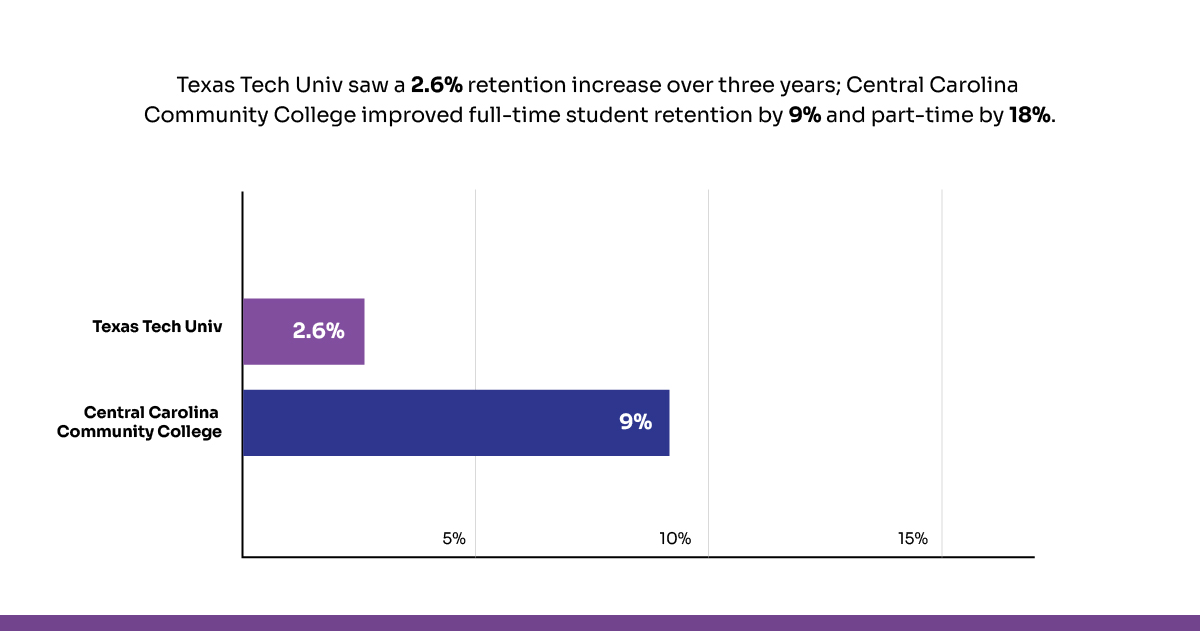
Personalized Outreach Increases Engagement & Yield
What’s changing
AI segments prospective students by preferences and behaviours, delivering tailored emails, ads, and messages that resonate personally.
Data & Impact:
- Students say a personalised message makes them more likely to explore a university further.
- AI-driven engagement tools have demonstrated a 34% increase in application starts when using behaviour-triggered retargeting ads.
Virtual Campus Experiences Boost Applications by Up to 67%
What’s changing
Immersive virtual tours, enriched with AI and AR/VR, bring campuses to life for remote prospects.
Data & Impact:
- Universities integrating virtual tours have seen up to a 67% increase in applications.
- Tours embedded in emails boost inquiry rates by 21%, generate 64% incremental leads, and yield 3.9 × higher campus-visit rates.
AI Optimizes Financial Aid & Equity
What’s changing
AI platforms match students to suitable scholarships and aid, ensuring no opportunity is missed, and the administrative load is reduced.
Data & Impact:
- Georgia State’s chatbot use correlated with higher FAFSA filings and registration among low-income and first-generation students.
- Higher education professionals report that 85% expect predictive models for enrollment and student success to grow, boosting equity in aid distribution.
Read more: Enrollment Tools: Best Student Enrollment Management Software & Systems
Summary
Student enrollment in 2025 is undergoing a major shift. With U.S. undergraduate numbers down by 2.7 million since 2010 and the “enrollment cliff” looming, colleges face growing pressure to attract and retain fewer but more selective students. Today’s learners expect speed, personalization, and digital-first experiences—20% decide on a college in just one week, and 58% choose based on brand over program.
In response, institutions have modernised their approach. AI chatbots now offer 24/7 support, predictive analytics flag at-risk students early, and CRM systems enable personalised outreach. These tools are making a measurable impact: AI-driven strategies have increased application rates by up to 67% and retention by up to 15%.
The result? A smarter, more responsive enrollment system that meets modern learners where they are—online, fast, and expecting real value.
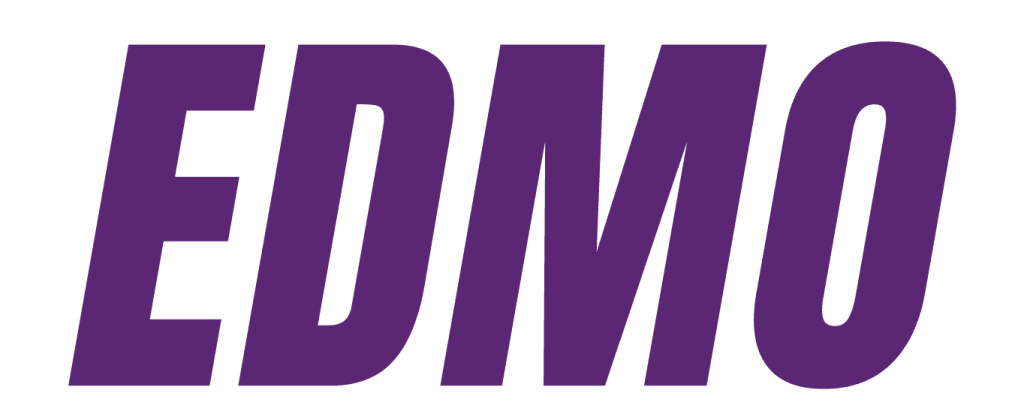






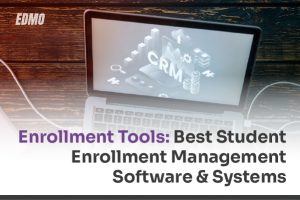
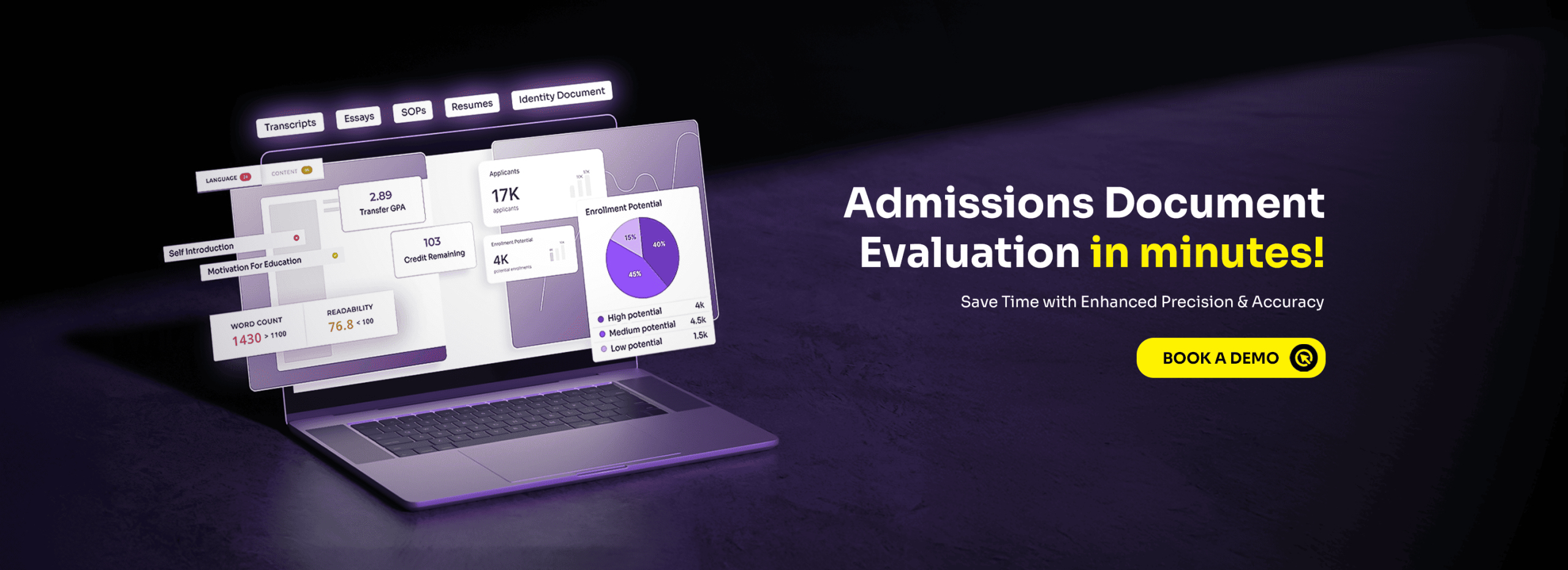

No comments yet. Be the first to comment!
Leave a Comment